

The OpenStructures blog. - Blog. Biohackers. The politics of open science. Alessandro Delfanti, Biohackers.
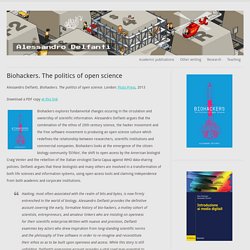
The politics of open science. London: Pluto Press, 2013 Download a PDF copy at this link Biohackers explores fundamental changes occuring in the circulation and ownership of scientific information. Alessandro Delfanti argues that the combination of the ethos of 20th century science, the hacker movement and the free software movement is producing an open science culture which redefines the relationship between researchers, scientific institutions and commercial companies. Alive. DIYbio. Biología DIY - Bionodo.
DIY Bio Europe - Community of European DIY Biologists. Young Engineer of the Year builds his own genetics lab – video. Synthetic Biology Map. BioHacking Leads to 3D BioPrinting? A report on TechCrunch describes the work of two bio companies, Genome Compiler and Cambrian Genomics.
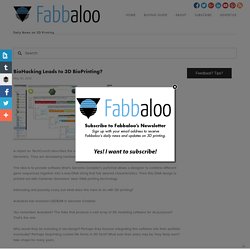
They are developing hardware and software to design and print (the DNA) of new life forms. The idea is to provide software (that's Genome Compiler's part) that allows a designer to combine different gene sequences together into a new DNA string that has desired characteristics. Body Hacking : “Je me modifie, donc je suis” Cyril Fiévet (@cfievet) ne nous est pas inconnu.
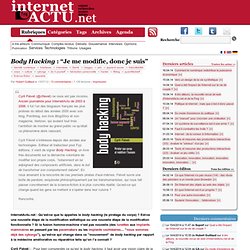
Ancien journaliste pour InternetActu de 2003 à 2006, il fut l’un des blogueurs français les plus prolixes du début des années 2000 avec son blog, Pointblog, son livre BlogStory et son magazine, Netizen, qui avaient tout trois l’ambition de montrer au grand public ce qu’était ce phénomène alors naissant. Chinese scientists uses 3D printer to print ear. Jul.9, 2012 In Nanjing Baoyan Automation Co., Ltd.

China, Dr. How 3D Printing The Human Body Works [Infographic] Blog du Fab Lab Artilect (Toulouse) “Design For Hack” in Medicine. Medical aid is a good story.

We’ve all seen articles about well-meaning groups donating X-ray machines and incubators to needy clinics in the developing world. What we don’t see are those same devices when they fail as little as six months later — or even dead on arrival — because they weren’t designed to operate in these environments. About 90% of medical technology that reaches poor countries is hand-me-down equipment designed for first-world facilities. Expecting it to keep working is like expecting a used Rolls-Royce to survive the Paris-Dakar Rally. And after it malfunctions, it’s usually junked. In response, some designers have felt that we need to send over cheaper versions of the high-end equipment, the equivalent of economy cars. Using the Drug Delivery MEDIKit in Nicaragua. Fortunately, increasing numbers of professionals in the medical equipment industry are becoming interested in applying this different design philosophy to devices aimed at developing countries.
Creating Transient Cell Membrane Pores Using a Standard Inkjet Printer. A description of the methods used to convert an HP DeskJet 500 printer into a bioprinter.

The printer is capable of processing living cells, which causes transient pores in the membrane. OpenPCR - the $599 Personal PCR Machine / Thermal Cycler. GenSpace NYC. BioCurious. 'Printing' human organs with 3D bio-printer. Open Space for Biology and Biotechnologies. Les bio-bidouilleurs s’enracinent. La première communauté de biologistes hackers a vu le jour il y a quelques mois en France.

Greffés au /tmp/lab, entre la Gaieté Lyrique et les locaux de l'Electrolab à Nanterre ils défrichent la génétique, pour le bien du citoyen. Un bain-marie, des agitateurs, une centrifugeuse, deux frigos (dont un pour les bactéries), une machine PCR (polymerase chain reaction, réaction en chaîne par polymérase, qui permet de séquencer le génome)… Tout le matériel, ou presque, accumulé par La Paillasse, le premier biohacklab français, vient de Génopôle, LE lieu de la recherche en génétique en France. Un donateur institutionnel et généreux dont la directrice de la recherche salue la « démarche citoyenne » des défenseurs du DIY (Do It Yourself, faites-le vous même) et de l’open source. « Il nous manque encore les consommables, des enzymes, des bactéries.
Je ne sais pas comment on va s’approvisionner auprès des fournisseurs, ils n’ont pas l’habitude de traiter avec des associations. Better bioprinting with stem cells. Schematic of the EB formation process using bioprinting approach.
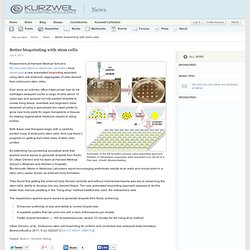
Blog » Blog Archive » Screen Your Genome Under $512, Open Sourcing Biology With OpenPCR. Screen Your Genome Under $512, Open Sourcing Biology With OpenPCR Davide Gomba — July 7th, 2011 Most of people working in the field of biological or scientific research should greet the open hardware applications we are witnessing in this age of Garage Science.
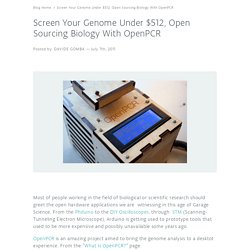
From the Phduino to the DIY Oscilloscopes, through STM (Scanning-Tunneling Electron Microscope), Arduino is getting used to prototype tools that used to be more expensive and possibly unavailable some years ago. OpenPCR is an amazing project aimed to bring the genome analysis to a desktot experience. 3-D printers may someday allow labs to create replacment human organs. But the goo is made of living cells, and the machine is “printing” a new body part.

These machines — they’re called three-dimensional printers — work very much like ordinary desktop printers. But instead of just putting down ink on paper, they stack up layers of living material to make 3-D shapes. The technology has been around for almost two decades, providing a shortcut for dentists, jewelers, machinists and even chocolatiers who want to make custom pieces without having to create molds.